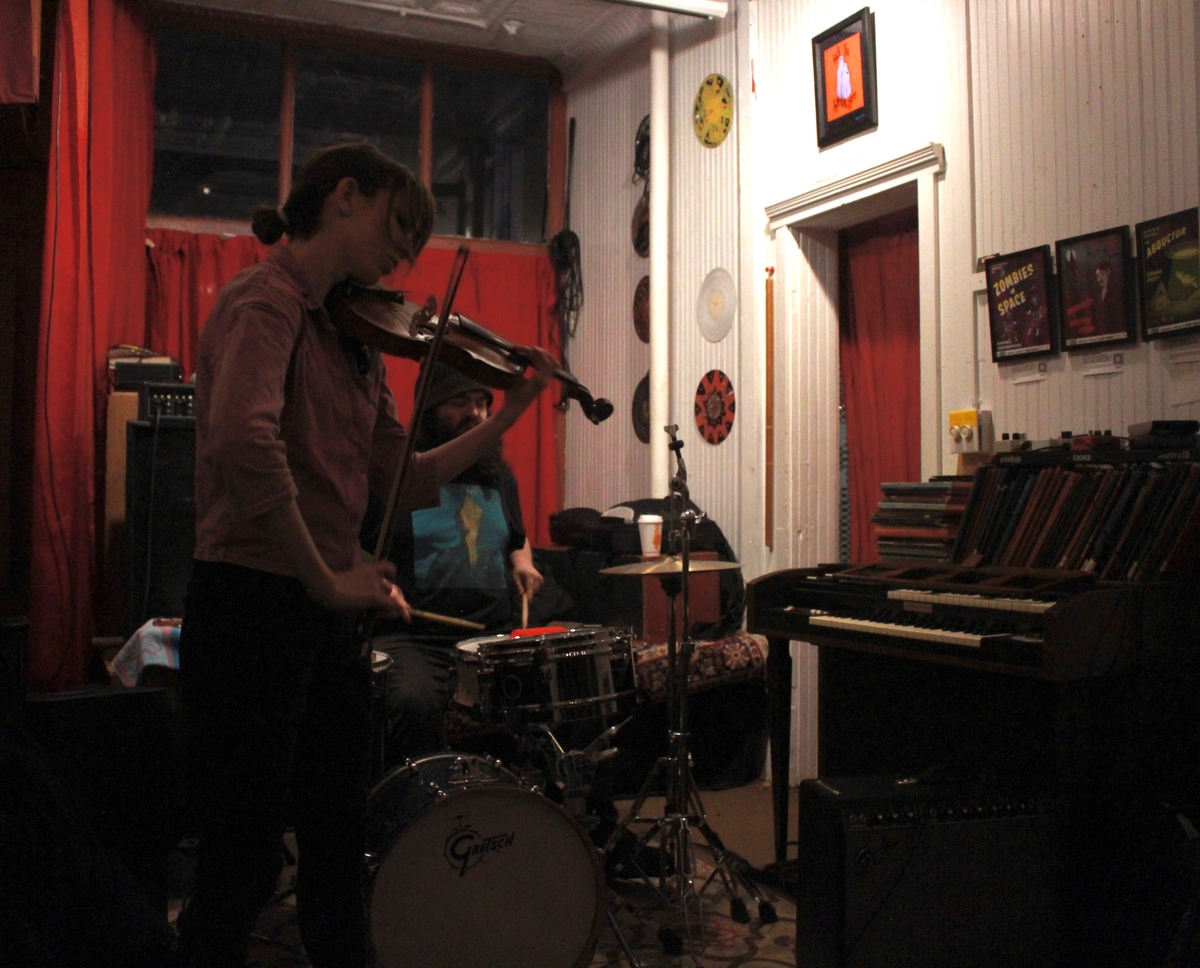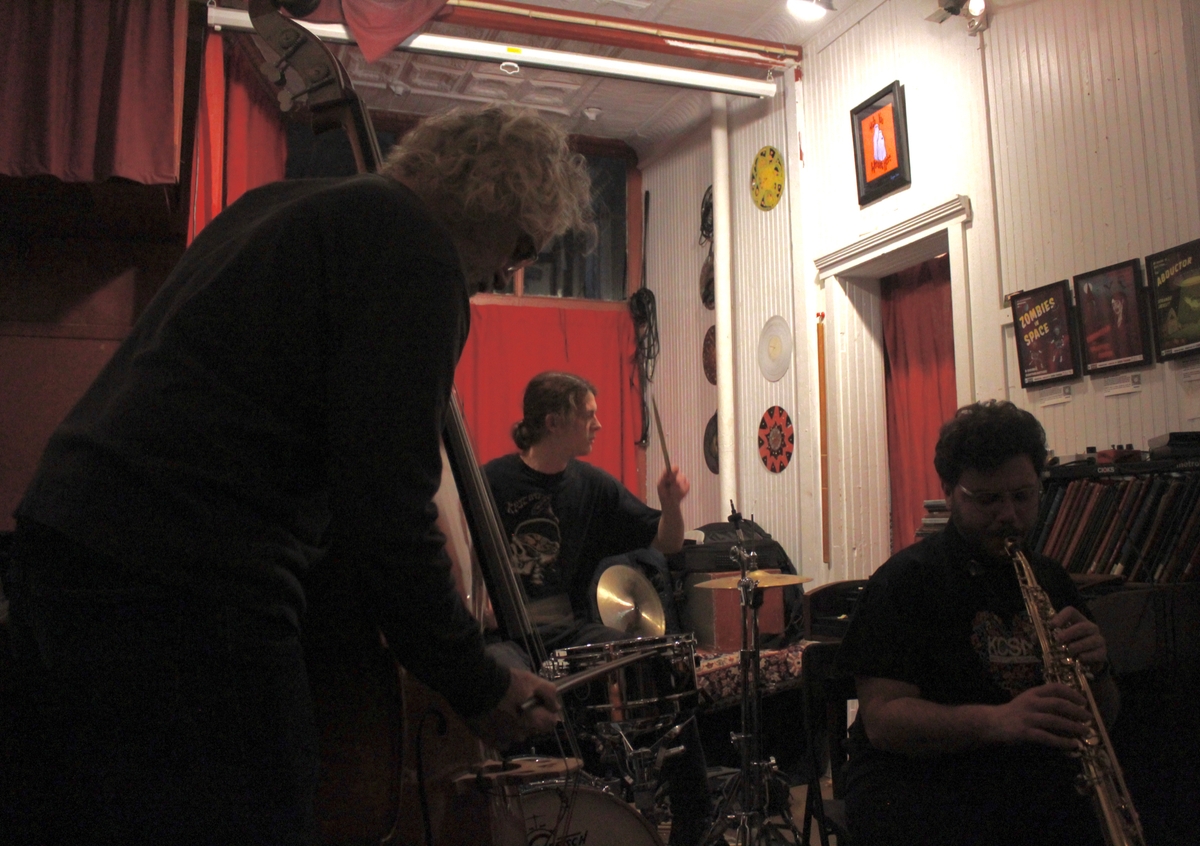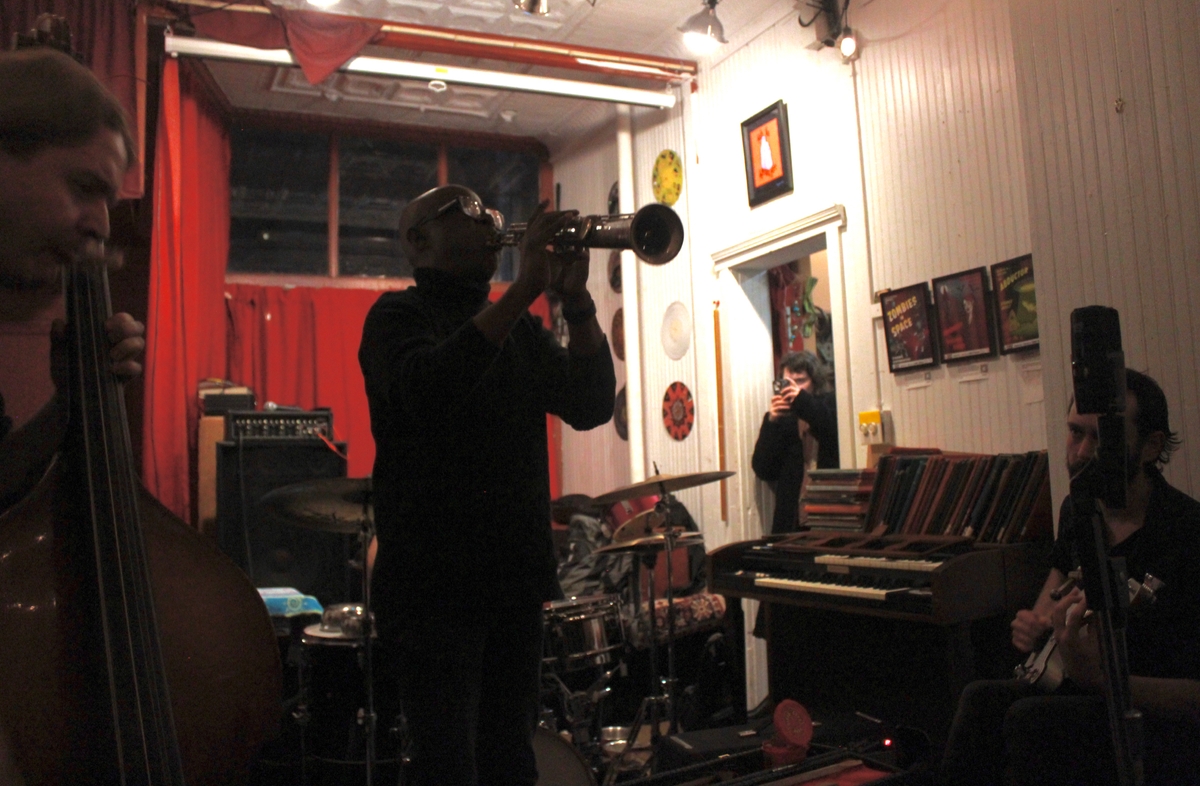
James Paul Nadien sat behind the drums with an impish grin as violinist Sabrina Salamone tightened the hair on her bow. “F.I.M. 50!” he yelled. The crowd, a packed room at Never Ending Books on a Saturday, cheered. It was an appropriately direct introduction for the 50th installment of the F.I.M. concert series, which was started in April 2022 by guitarist Luke Rovinsky and bassist Caleb Duval and has quickly become a linchpin of the Elm City improvised music scene, joining the New Haven Improvisers Collective and the Instantiation series to solidify the next generation of players.
The F.I.M. celebrated its 50th installment by stretching it over two nights. Friday had featured three sets of music. Salamone and Nadien were responsible for the first set of the second evening. Salamone started with long, searching tones, moving upward through the instrument’s range. It was an onramp for Nadien, who built the sound behind her. Together, for a minute they sounded like five people, filling the room with sound. Then Salamone took a turn, dropping the volume and throwing out fluttering notes. That was Nadien’s chance to grab a small plastic pig and squeeze; the toy’s tone matched what Salamone was doing. It also conveyed an important point: that improvised music is as much fun as it is serious, and part of any conversation is the ability to tell jokes. A few in the audience took the opportunity to laugh out loud.
Salamone then unleashed a cascade of scrubbing notes. Nadien matched her energy. They both dug into their instruments. Salamone pulled all the tone she could give, finding and deploying hard, biting sounds that most violinists are afraid to make, while Nadien began using all of the drums, whether it was pressing a stick into the head to make it moan or coaxing squeals out of the sides with his fingers. It culminated in a burst of frantic energy. Salamone made another turn, stirring up a thick, lugubrious melody that Nadien punctuated with drum hits like gunshots. The two instruments came together in a roll that they let melt into dense chaos, from which they pulled pummeling waves of sound. They flew through a series of musical ideas, then checked back where they started.
Then Salamone let Nadien go. He picked something like a meter, a fast trot. Salamone fell in, and together they brought it down, wrapping it in nervous energy that gave Nadien a chance to produce even more toys — a green elephant and a couple more pig heads, one of which Nadien winged at drummer Michael Larocca in the audience. Larocca tossed it back.

Next up was Kaelen Ghandhi on saxophone, Joe Morris on upright bass, and Kevin Murray on drums. Ghandhi and Morris took the lead with whistling sounds from their instruments. Murray picked up the energy, delivering hits like a pinball machine. Morris dropped into a rumbling bass line while Ghandhi got busy. Murray began a stumbling set of ideas that Morris followed him on, while Ghandhi floated over the top.
As the trio’s set continued, they settled into a core idea that might be described as stripping the idea of a small jazz combo to its essence. There was no prescribed tune or any defined structure, but together the three musicians ably delivered a hot jazz trio’s sense of crackling propulsion, harmonic density, and melodic exploration.
Then Morris dropped out, and Murray and Ghandhi headed into noisier territory. Murray then dropped out, and for a brief moment, Ghandhi was alone, still charging ahead. Morris and Murray returned with a fresh set of ideas, Morris exploring harmonics while Murray assailed the head of one of the toms to produce a sound almost like a dog barking. The momentum returned, now even wilder on the edges. Morris and Ghandhi gave Murray a chance to play alone for a moment. Then Ghandhi returned, on wrenching, wailing soprano while Morris scrubbed the bass with his bow, an echo of what Salamone had done.
They kept searching and returning to the core sound they had made, though not without some fascinating detours, including a passage in while all of them found a way to produce a shifting cloud of sound. After another burst of activity, Murray dropped out, and let Ghandhi and Morris finish together, just as they had started.

Rovinsky, Duval, and Larocca — a.k.a. Bookers — took the stage on guitar, bass, and drums, accompanied by Sam Newsome on soprano saxophone. With a ripping sound from Duval’s bass, the three F.I.M. regulars were off like a shot, creating a skittering, urgent maze of musical ideas for Newsome to navigate. He strolled in with a few phrases, then held a note that the other three jumped on, creating ominous swells of sound before exploding in a different direction.
On a night of utterly confident players giving it their all, the quartet was the most aggressive, and most aggressively playful. The central idea of their set was to burn through ideas, with a distinct predilection for industrial sounds, metallic, clanging, the sounds of things blowing apart, flying together, and bursting apart again. Rovinsky set up a punishing howl built from distortion and feedback. Larocca responded with an insistent bell while still revving the music’s engine with one phrase after another. Duval stuck a metal rod between his strings and hit it three times, forcing it all in a new direction.
Standing in the middle, Newsome unleashed an alarm-like sound, like an air-raid siren for a war 100 years from now. Waving the bell of his horn in the air, he bounced the sound off every surface in the room. Duval now had a piece of wood jammed in his strings that he bowed, while Rovinsky got sounds out of his guitar that made it sound like it might be short circuiting.
All four players headed to the limits of the tones of their respective instruments to the point that it was sometimes difficult to tell, in the best sense, who was doing what. They found common ground in cacophony. Newsome hauled out a tiny toy piano and proceeded to play note clusters on it with the bell of his horn. This brought the humor to the fore, giving the music the air of the soundtrack to a frenetic episode of Looney Tunes. Newsome then attached a plastic hose to his instrument, pulling almost electronic sounds out of it; for a time he then played with no mouthpiece at all. Toward the end of the set, Duval pounded four times on the bass strings with a drumstick, a rhythm Larocca immediate caught, elaborated on, and then eviscerated. At once, it all stopped on a dime.
The audience let out a collective yeah!
“That it, that’s the 50th. It’s over. We did it,” Larocca said.
“No, now it’s on to another 50,” an audience member said.
“Yeah, make it 100,” someone else said.
“No,” Duval deadpanned. “It’s over.”
Everyone laughed.
For a list of past F.I.M. shows, announcements of future shows, and albums of improvised music, visit F.I.M.‘s website.

Nowhere in the article is there an explanation of what word the letters stand for.
Just asking. . .